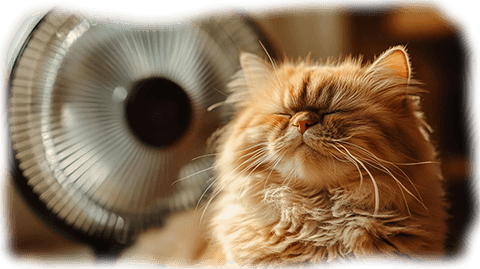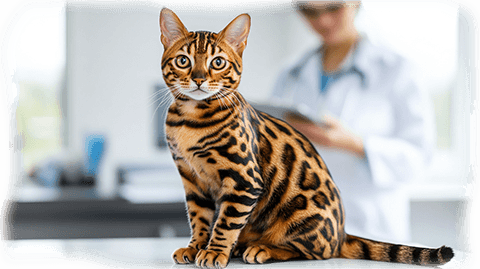Persian Cats Health: Common Issues and Helpful Tips
Persian cats are one of the most beloved and recognizable cat breeds, known for their long, luxurious coats and distinctive flat faces. However, their unique appearance also brings with it certain health challenges. As a Persian cat owner, being aware of common health issues and preventive care can ensure that your Persian cat enjoys a long, healthy life.
Brachycephalic Syndrome
One of the most prominent features of Persian cats is their flat face (known as brachycephaly). Unfortunately, this adorable trait can lead to respiratory issues due to their compressed airways.
Signs of Brachycephalic Syndrome
- Noisy breathing (especially during sleep)
- Snoring
- Difficulty breathing, especially during exercise
- Heat sensitivity
Tips for Managing Brachycephalic Syndrome
- Keep your Persian cool – Avoid exposing your Persian to extreme heat or humidity, as they may struggle to breathe in these conditions.
- Monitor exercise – Persian cats aren’t overly active, but be mindful of their activity levels. Overexertion can lead to breathing difficulties.
- Regular vet check-ups – Keep your vet informed about any changes in your Persian’s breathing. Severe cases may require surgical intervention to widen the nostrils or shorten the soft palate.

Polycystic Kidney Disease (PKD)
Polycystic kidney disease is a genetic condition common in Persian cats. This disease causes fluid-filled cysts to develop in the kidneys, eventually leading to kidney failure.
Signs of PKD:
- Increased thirst
- Frequent urination
- Weight loss
- Lethargy or lack of energy
- Loss of appetite
Preventing and Managing PKD:
- Regular screening – If you own a Persian cat, consider genetic testing early on to determine if they carry the gene for PKD.
- Early detection – Annual vet check-ups and blood tests can catch kidney issues early, allowing for better management.
- Hydration – Encourage your cat to drink plenty of water (Amazon affiliate link) to support kidney function. Wet food can also help increase hydration.
- Dietary adjustments – Consult with your vet about adjusting your Persian’s diet to reduce the strain on their kidneys, particularly if they are diagnosed with PKD.

Dental Disease
Due to their flat faces, Persian cats are prone to dental problems. Their teeth may be overcrowded or misaligned, leading to plaque buildup and gum disease.
Signs of Dental Disease
- Bad breath
- Red, swollen gums
- Difficulty eating
- Drooling or pawing at the mouth
- Loss of teeth
Preventive Dental Care
- Regular brushing – Use a cat-friendly toothbrush and toothpaste (Amazon affiliate link) to brush your Persian’s teeth a few times a week.
- Dental treats and toys – Provide your Persian with dental chews or toys designed to reduce plaque and tartar.
- Vet check-ups – Make sure your vet checks your cat’s teeth during routine exams, and schedule professional cleanings if needed.

Eye Problems
Persian cats have large, round eyes that can be prone to irritation, excessive tearing, and infections. Their flat faces can make it difficult for tears to drain properly, leading to tear staining and infections.
Common Eye Issues:
- Tear staining – Dark tear stains are common in Persians due to improper tear drainage.
- Conjunctivitis – Swelling or infection of the eye’s lining can lead to discharge and redness.
- Corneal ulcers – Scratches or irritation to the surface of the eye can lead to ulcers, which require immediate attention.
Tips for Eye Care
- Daily cleaning – Wipe your Persian’s eyes daily with a soft cloth (Amazon affiliate link) or cotton ball dampened with warm water to prevent tear staining and infection.
- Regular vet visits – If you notice excessive tearing, redness, or discharge, consult your vet immediately to prevent more serious conditions.
- Use eye drops – In some cases, your vet may recommend eye drops or ointments to manage irritation or infection.

Coat and Skin Care
Persian cats are known for their beautiful, long coats, but their fur requires regular care to prevent tangles, matting, and skin issues. Additionally, their thick coat can make them more prone to skin problems.
Common Coat and Skin Issues
- Matting – Without regular grooming, Persian cats can develop mats in their fur, which can pull on their skin and cause discomfort.
- Skin infections – Mats can trap moisture and dirt against the skin, leading to infections.
- Seborrhea – Some Persian cats may develop seborrhea, a condition that causes flaky skin and excess oil production.
Coat and Skin Care Tips
- Daily brushing – Use a wide-toothed comb or a slicker brush to gently brush your Persian’s coat (Amazon affiliate link) every day to prevent matting.
- Bathing – Give your Persian a bath every few weeks to keep their coat clean and free of oil buildup. Use a cat-friendly shampoo designed for long-haired breeds.
- Check for skin irritation – While grooming, check your Persian’s skin for any signs of redness, inflammation, or unusual lumps.
- Professional grooming – Consider professional grooming if your cat’s coat becomes unmanageable or if they develop severe mats.
Obesity
Like many domestic cats, Persians are prone to obesity, especially because they are not naturally active. Obesity can lead to further health problems, such as diabetes, joint pain, and heart disease.
Preventing Obesity
- Portion control – Measure out your cat’s food and avoid overfeeding. Consult your vet for the proper amount of food based on your cat’s weight, age, and activity level.
- Encourage exercise – While Persians aren’t the most active breed, interactive toys (Amazon affiliate link), scratching posts, and laser pointers can help get them moving.
- Monitor weight – Keep an eye on your Persian’s weight and body condition. If they start to gain weight, consult your vet to adjust their diet and exercise routine.
Conclusion
While Persian cats are prone to several health issues due to their unique features, proactive care and regular vet check-ups can help manage these risks. By being aware of common health problems like brachycephalic syndrome, PKD, dental disease, and eye infections, you can take steps to keep your Persian happy and healthy for years to come. Regular grooming, a balanced diet, and prompt medical attention are the keys to ensuring your Persian lives a long and comfortable life.
Further reading: “PERSIAN CAT HANDBOOK: The complete guide to Persian cat care, training, breeding, health, behavior, nutrition, home setup, grooming, handling, socialization, and lots more” (Amazon affiliate link) by Bobby Woolsey.
Affiliate Disclosure
This post may contain affiliate links, which means I earn from purchases made through links. Please see the privacy policy page for more details.





